LONG-TIME JUNGLE VISITORS will remember Ken Lacy, aka “The Fabulous Orcboy,” who wrote several posts and contributed to many battle reports and campaigns under the old version of this site. Ken is a 40K veteran, a literal scholar, and a true gentleman whom I have been proud to know for over 20 years.
I’m thrilled that Ken has returned to wargaming after a lengthy hiatus, and honored that he has chosen to share this experiences and insights with the Jungle.
–Kenton
Well, as the old fogeys like me say, it’s been a minute.
Years ago, I spent over a decade really into the competitive wargaming scene; mostly 40K, but also Fantasy, Ancients, Historicals… you name it. That’s when I met Kenton and first starting reading (and intermittently contributing to) the Fighting Tigers of Veda site. Those were the halcyon days when Justin Timberlake was better known for being N’Sync, before either Drake and Bieber were Canadian megastars, back when our two most recent Presidents were best known for being in kid flicks like Home Alone 2 and Carmen Sandiego… as well as talking about running for President (mostly for the free publicity) every four years like clockwork.
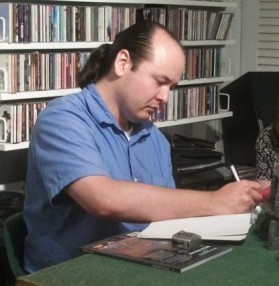
So yeah, a long time ago. And when life happened, and Games Workshop started becoming even more predatory than “free-to-play” game apps, I became less of a competition gamer, and more a modeler and hobbyist. I dropped out of the Games Workshop orbit, and dabbled with skirmish games that demanded less investment of time and money: the whole gamut, but primarily Warmachine and Hordes. And then Covid hit. Yeah, wasn’t that a thing and a half.
Suffice to say, it’s been a few years since I played any table-top wargames at all, and at least a dozen since I played Games Workshop games with any regularity. But in the last year or so, I’ve gotten back into the hobby side of wargaming (through Battletech’s new miniature offerings, of all things!), and I was convinced by a good friend to attend the 2023 NovaCon gaming convention in our nation’s capital. It’s become both bigger and less expensive (an amazing trick) than I remember it being pre-Covid, and comes with a massive wealth of gaming options.
I thought at first that I would jump back into table-top wargaming with some giant stompy robot Battletech (or Alpha Strike) goodness, but was intrigued by the unexpected confluence of two things: a narrative campaign offering of linked 40K battles over four days (as opposed to a cut-throat competitive tournament), and a new 10th edition of 40K with a free ruleset, clearly intended to draw noobs and veterans (like me) back into the hobby.
Over the course of this and the next few posts, I wanted to share my journey back to the table-top, both in preparation for the NovaCon convention this summer, as well as my experiences after a long hiatus from 40K wargaming.
One of the benefits of being an old man gamer like myself is that I have a sizable collection of armies and a wide range of models at my disposal – I’ve even painted a sizable portion of them, though I’ve got plenty of raw plastic and bare metal in my pile of shame.
Although I’m primarily drawn to alternative sculpts and companies since drifting away from Games Workshop – because I struggle to properly appreciate the newest GW models, both in terms of price and overall design aesthetic – I still have a sizable collection of official GW miniatures that I can use in tournaments and quasi-official events. In terms of a convention event, requiring army lists of either 1500 or 2000 points, and with a stated preference for official models, this meant that I could field (without having to use alternative sculpts or proxies) the following a half-dozen or so 40K armies.
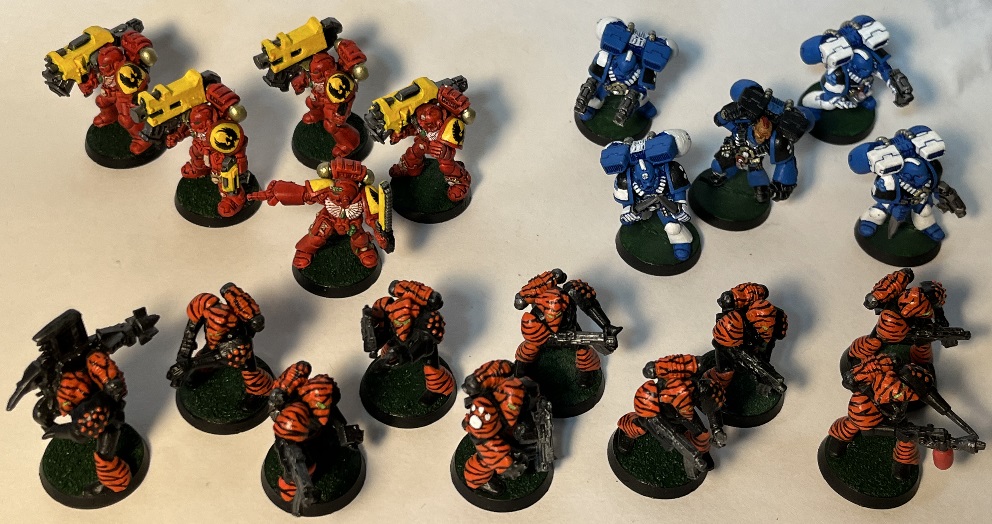
Option 1: Space Marines. It’s a truism that every 40K gamer has a Marine army, and certainly it was one of my original armies. But I haven’t actively collected Marines (or Marine proxies) since the late 1990s, meaning that I’ve got almost exclusively First-Born, aka non-Primaris Marines. And although the current Marine stat-line is very appealing (two Wounds! Amazing!), I’ve never had much interest in playing any flavor of generic or main-stream T4 3+ power armor bolter-boy.
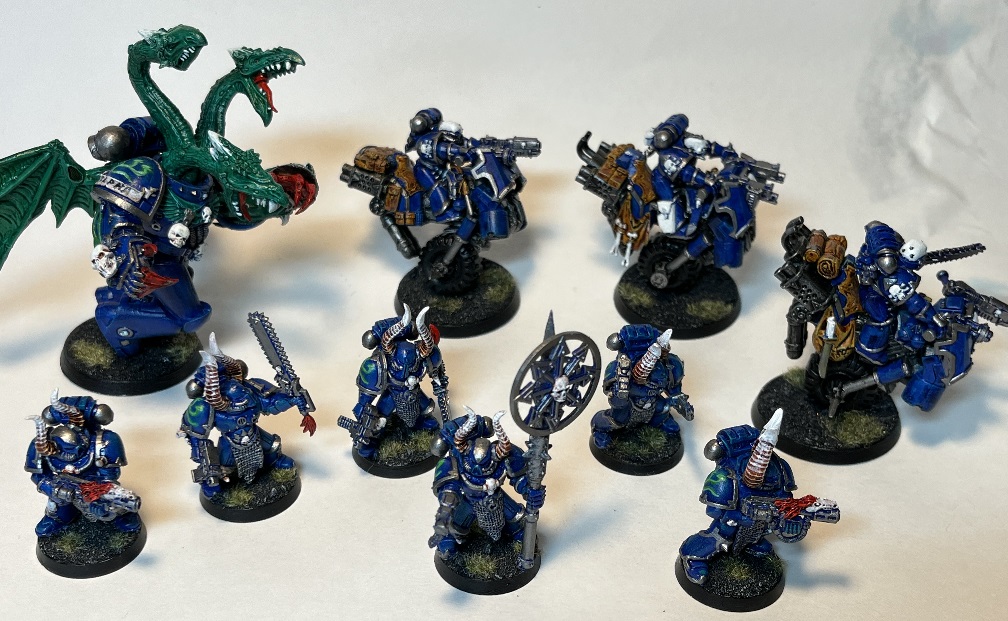
When I’ve played Marines in the past, it’s always as something off-beat, like the all-Devastator army list, or the all-Dreadnought list, or the Completely 100% Ministorum-Approved Praise To The Emperor Imperial Cult Supported By Super-Loyalist Blue Hydra Chapter Marines. Plus, this summer (2023), GW decided that First-Born were going to all become Legacy units, and henceforth, Marines would go all-in on Primaris from 10th edition forward. I mean, there’s about 5000x more Marine units than any other army list, so this was basically necessary to keep the Marines from being too repetitive and bloated, but this also meant that my fuddy duddy First-Born were out.
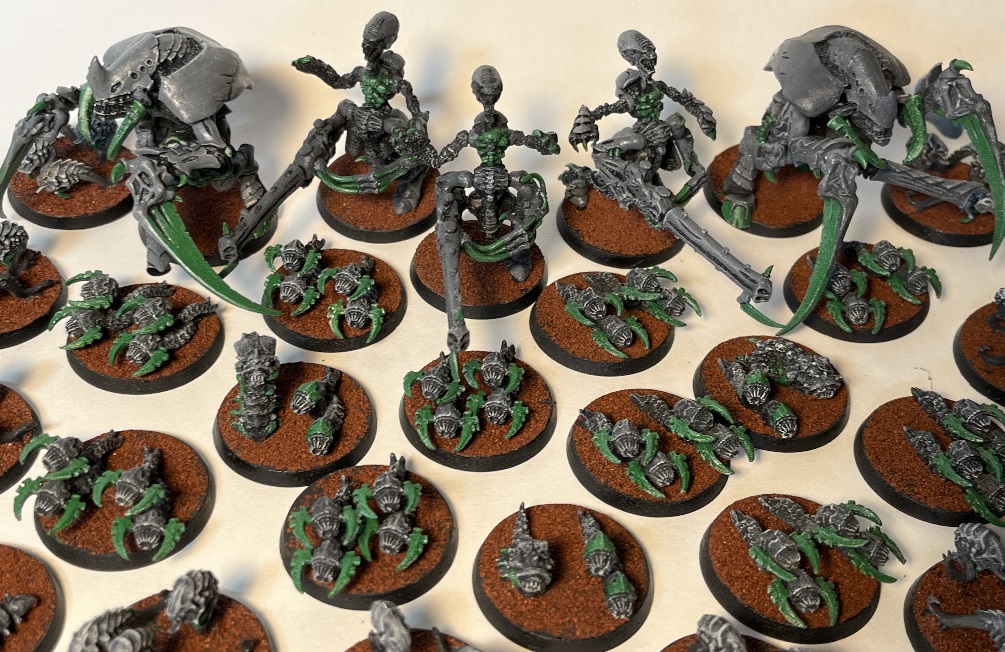
Option 2: Tyranids. Another army that I’ve usually played with only off-beat lists. I originally created it in 3rd edition to play a Ripper Swarm army list in which every Ripper effectively had (by 10th edition rules) the Devastating Wounds ability. It was hilarious and disgusting and actually rather challenging to win objective games with, because Rippers (as Tyranid players are well aware) cannot hold objectives; their OC value is a lovely round “zero”.
Since 4th edition, I’ve therefore played them as a Big Beastie list packed with Carnifexes and Tyranid Warriors, surrounded by a swarm of speed-bump Ripper Swarms, and while that’s still plenty viable, I would find it a little dull from the point of a view of a narrative campaign. Try as I might to view them through the lens of an alternative genre, I’ve always found the Tyranids to be inherently nihilistic, in the classic 1980s British pop-culture fashion of Judge Dredd and Watchmen (referring to Alan Moore). And that’s just not my bag, baby. So, Tyranids were out.
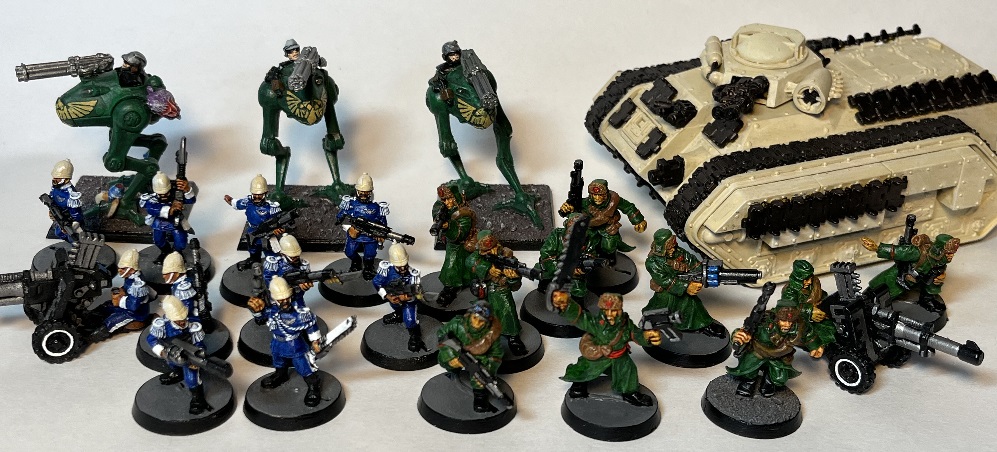
Option 3: Astra Militarum, or the Imperial Guard. Probably my first love, and at this point, I’ve got over forty painted units and a dozen vehicles of various types. I’ve been collecting and painting regular old T3 humie grunts (plus the occasional abhuman) for over thirty years, and even though I’ve still got more units to assemble and paint (another forty units and dozen vehicles, at least), I’ve got so many different options and models and ranges that I can field over 80% of everything in the 10th edition list… even after a hiatus of a dozen years.
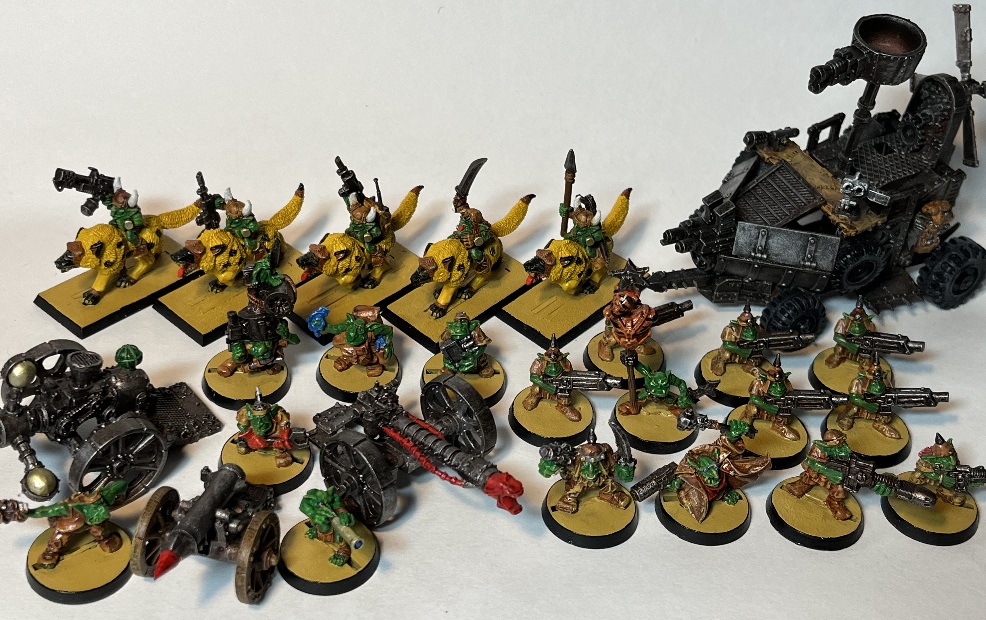
I even have a full Rebel Grot list, with a hundred Gretchin models proxying as an Astra Militarum force, and can easily expand the list as necessary with another hundred Gretchin or so still on the sprue.
If this was a mega-battle, I’d bring the Guard (Militarum) without missing a beat, but for a weekend campaign at a convention, where I’m having to lug miniatures cases and carrying cases back and forth every day, including on the DC Metro? I love the Astra Militarum, even if they rebranded solely so that GW could trademark the name, and the Rebel Grots are an absolute blast… but when you tune in and grok real-world logistics, the Guard are a total bummer. So, I was going to have to find something more portable.

Option Four: Eldar. Although I really enjoy the army and aesthetic (specifically, the original Jes Goodwin designs), I’ve found so much of the model range since the late 1990s to be either awkwardly static or chunky (or both), instead of sleek and exotic. As a result, my Eldar were the first army where I first started fielding large numbers of proxy models (like my converted Exodite list, built out of the old Wood Elf and Lizardmen model lines), and much of my current Eldar army is made of conversions or non-GW alternative models.

But I admit I was still very tempted here – there’s a lot of possibilities in an Eldar list, not least of which they can really put a hurt on T4 power-armor boys, and I’ve plenty of official GW (or GW-based conversion) models that go with that flow. Ultimately, however, I passed on the Eldar because their vehicles and walkers have so many wings and extensions and curlicues… and as a result, they are quite bulky to transport, even when they’re in relatively light-weight plastic. Real downer.

Option Five: Chaos Demons. I deliberately put this army together with an array of proxy models from alternative miniature companies, back in the early 2000s as a form of protest against GW’s already predatory pricing…. Plus, I hated the aesthetic and sculpts of the original (and virtually all subsequent) Chaos Demon miniatures put out by Games Workshop. And in terms of narrative, my Chaos Demons are full of character – I reskinned them as cyborg bioweapons fielded by a remnant Age of War human civilization that has retained its advanced technology and refused to be assimilated into the Imperium.
But the problem is: my collection is nearly all proxy models, and this NovaCon event really prefers readily identifiable units for the sake of the other players. Would my opponents dig my cosmic mellow, or just space out? So while I really enjoy the speed and firepower of this army, and it’s eminently portable, I gotta get real and find something else.
This meant that I ultimately narrowed my choices down to one of two options.

Option Six: T’au. Years ago, I heavily converted a badly battered second-hand T’au army to be a “Slann” army, complete with lizardman greeblies and heads, and then gave them a cheerful Mighty Morphing Power Rangers color scheme. There are a few alternative models here, but all my conversions are still easily recognizable for the T’au models they are intended to be, and as a mostly-infantry force, the entire army is quite portable, aside from the proxy Imperial Knight-sized units (Riptides and Stormsurges) which I’d probably leave at home rather than cart around DC all weekend.
The major weakness of a T’au list is, of course, the complete inability to compete in the Fight phase, but I solved this problem many years (and many editions) ago: field a small detachment of something very close-combat capable. I found that dropping four or five dozen cheap-as-chips Ork Boyz on the table between the enemy and my T’au big guns usually solved that problem quite effectively, far better than using Kroot or any of the other in-army alternatives – even if they were a separate detachment and unable to benefit from army-wide abilities or stratagems. And since I was fielding “Slann” themed Tau, adding a few allied Krork models totally fit the vibe.
Option Seven: Sisters of Battle. I’ve had this army since their very first release in the 1990s, because I’ve absolutely loved the Sororitas aesthetic going all the way back to the classic John Blanche illustrations and “Sister Sin” in the original Rogue Trader book (1st edition 40K).

Over the years, I’ve collected a sizable force, mostly cast-offs from friends over the years. That’s not even including the many proxy and alternative models that I’ve acquired in the decades when GW was basically not releasing new Sisters models.
After reading the Ciaphas Cain novels, I was inspired to field them as an anti-grimdark army, and what’s more of a contrast to the 1980s grim-dark neo-nihilism of 40K than a 1960s “Flower Power” aesthetic, complete with bright colors and Rhino-chassis vehicles (Immolators and converted Exorcists) decorated like hippy VW vans? I threw in what is now a very dated pop-culture reference, having them led by Inquisitor Austin Powers, Interstellar Man of Mystery.

Instead of “Miracles”, the Groovy and Swingin’ Sisters of Battle are powered by the Emperor’s Love in the form of “Mojo”. As a bonus, the army is extremely portable, as my collection is heavy on small-base infantry and light on big-base walkers, and the old-school 1980s-era Rhino models in my list are quite compact and pack tightly together.
What ultimately made up my mind for me was none other than the esteemed Kenton Kilgore, proprietor of this very website. Over the years I’ve known him, he’s been forced to face off against every one of the armies above, and by far the list he found the most entertaining to play against was the Swingin’ Sisters.
You see, the systemic problem with the T’au – as well as the Guard (Astra Militarum) — are that they are so one-dimensional as armies that making them table-top viable necessitates finding ways to neuter the Fight phase, and simply swamp the field with so many models that the limited mobility of these lists is outweighed by a combination of long-ranged firepower and weight of OC (objective control). This is, to put it plainly, not a lot of fun for most opponents, who find that they’re basically unable to do a whole heck of a lot during their own turn, in exchange for having entire swathes of their army erased during my Shooting phase.
The Sisters, on the other hand, are a close-ranged army that relies on getting in the opponent’s grill in order to do real damage (Exorcists aside, and even a full complement of these far-out beauties lacks the weight of firepower that a typical Tau or Guard army brings). And because Sisters of Battle actually receive in-game “Mojo” benefits when they lose models and entire units, this encourages me to be quite aggressive with them, more open to sacrificing units or leaving them extremely exposed – all of which is much more entertaining for an opponent, who can in their turn jump in and smash the poor old T3 basic-humie Sisters into the dirt.
As an added bonus, fielding the Swingin’ Sisters at NovaCon gives me some primo incentive to assembling and painting several dozen models that I’ve simply never gotten to in a long, long time; of all my 40K armies, the Sisters are probably the one where I’ve finished painting the fewest models.
So, next time – a look at my preparation process: what models I’ll need to finish in the month of August, and what army lists I’ve conjured up for NovaCon 2023 – three or four editions and many more years since I last played the Sisters in 40K. Check it out here.
